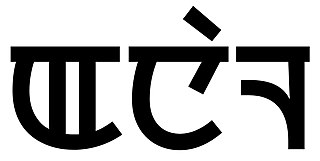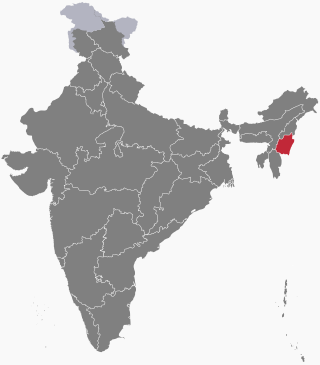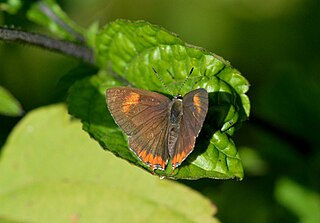
Manipur is a state in northeast India, with the city of Imphal as its capital. It is bounded by the Indian states of Nagaland to the north, Mizoram to the south and Assam to the west. It also borders two regions of Myanmar, Sagaing Region to the east and Chin State to the south. The state covers an area of 22,327 square kilometres (8,621 sq mi). The official and most widely spoken language is Meitei language. Native to the Meitei people, it is also used as a lingua franca by smaller communities, who speak a variety of other Sino-Tibetan languages. Manipur has been at the crossroads of Asian economic and cultural exchange for more than 2,500 years. It connects the Indian subcontinent and Central Asia to Southeast Asia, East Asia, Siberia, regions in the Arctic, Micronesia and Polynesia enabling migration of people, cultures and religions.

Meitei, also known as Manipuri, is a Tibeto-Burman language of northeast India. It is the official language and the lingua franca of Manipur as well as one of the 22 official languages of the Indian Republic. Native to the Meitei people, it is spoken by around 1.8 million people, predominantly in the state of Manipur, but also by smaller communities in the rest of the country and in parts of neighbouring Myanmar and Bangladesh. It was used as a court language in the historic Manipur Kingdom.

The Meitei people, also known as the Manipuri people, are the predominant ethnic group of Manipur in Northeast India. They speak Meitei language, one of the 22 official languages of the Indian Republic and the sole official language of Manipur. The Meiteis primarily settled in the Imphal Valley region in modern-day Manipur, though a sizable population has settled in the other Indian states of Assam, Tripura, Nagaland, Meghalaya, and Mizoram. There is also a notable presence of Meitei in the neighboring countries of Myanmar and Bangladesh. The Meitei ethnic group represents about 53% of Manipur's population.

The Chindwin River, also known as the Ningthi River, is a river flowing entirely in Myanmar, and the largest tributary of the country's main river, the Ayeyarwady. Its official name is also spelled Chindwinn.

Anal or Anāl, also known as Pakan Naga after the two principal villages where it is spoken in, is a Southern Naga language, part of the Sino-Tibetan language family, spoken by the Anal people in India and a dwindling number in Myanmar. It had 83,000 speakers in India according to the 2001 census, and 55,000 in Myanmar in 2010. It has two principal clans, Murchal and Moshum, and is closest to Lamkang. The language of wider communication is Meitei language. The name "Anal" was given by the Meitei people of Manipur valley. Anal is written in the Latin script, with a literacy rate of about 87%.

The Tangkhul people, also known as the Tangkhul Naga, are a Tibeto-Burmese ethnic group living in the Indo–Mayanmar border area, occupying the Ukhrul district and Kamjong district in the Northeast Indian state of Manipur, and in parts of neighboring Myanmar. Despite this international border, many Tangkhul have continued to regard themselves as "one nation". The name "Tangkhul" is originated from the Meitei language words, "Tang" meaning "scarce" and "Khul" meaning "village" respectively. According to another theory of origin, the term "Tangkhul" is derived from "Thankhul", meaning "Than village" in Meitei language.

Gharib Nawaz was a Meitei ruler of Manipur Kingdom, ruling from c. 1709 until his death. He introduced Hinduism as the state religion of his kingdom (1717) and changed the name of the kingdom to the Sanskrit Manipur (1724). He changed his royal name from his birth name Pamheipa to the Persianate Gharib Nawaz.

Charairongba also known as "Eningthou Ningthem Charairongba" was the Meitei king and the ruler of Kangleipak from 1697 to 1709.

The Vaiphei people is an ethnic group who live in North-East Indian state of Manipur and its neighbouring country of Myanmar (Burma). Lt. Colonel J. Shakespeare (1887–1905), the first superintendent of the then Lushai Hills, referred to them as one of the Kuki clans of Manipur and recognized as part of the Chin-Kuki-Mizo tribe by the state government of Manipur. The group is originally from the Siyin valley located in the northern part of Chin State. The group speak the Vaiphei language.
The Imphal River, also known as the Turel Achouba, is a major river in Manipur state, northeastern India which originates from the northern side of Kangpokpi district. It is a tributary of the Manipur River, joining it in Thoubal district. It flows past Loktak Lake and the city of Imphal and joins the Lilong River, some 10 kilometres (6.2 mi) to the south. It flows towards Myanmar (Burma), marking the end point at 23°59'49.2"N 93°44'29.7"E. It then goes south meeting Myittha River at 22°53'24.19"N, 94° 5'1.79"E. Myittha river flows towards north and meets Chindwin River at 23°11'36.82"N, 94°18'38.28"E. Chindwin river then meets Irrawaddy River at 21°25'23.85"N, 95°16'47.56"E. Irrawaddy river then flows south till it ends at Andaman Sea, adjoining the Bay of Bengal and thereby connecting Imphal city to the sea. Imphal River was used by Japanese soldiers in boats to reach Imphal in World War II.

Tangkhul is a Sino-Tibetan language of the Tangkhulic branch, spoken in 168 villages of Ukhrul district, Manipur, India. The term "Tangkhul" is derived from the Meitei language terms, "Tang" meaning "scarce" and "Khul" meaning "village" respectively. According to another theory, the term "Tangkhul" is derived from "Thankhul", meaning "Than village" in Meitei language.

"Sidaba Mapu" or Salailel is the Supreme God, Creator of the universe and the Sky God in Meitei mythology and religion. According to Meitei mythology, Sidaba Mapu, being the Creator of the Universe, from a philosophical theory known as Leithak Leikharol Nongsemlon and Leisemlon.

The following outline is provided as an overview of and topical guide to Manipur:

Leimarel Sidabi or Leimalel Sitapi is a goddess in Meitei mythology and the religion of Ancient Kangleipak. She is the highest female divinity in the Meitei pantheon. She is the goddess of earth, of nature and the household. She is revered as the mother of every living being in the universe.

Panthoibi, also known as Nongpok Leima, is a goddess associated with civilization, courage, fertility, handicraft, love, victory, warfare and wisdom in the mythology and religion of Ancient Kangleipak. She is a consort of the God Nongpok Ningthou. She is considered to be one of the divine incarnations of Leimarel Sidabi and is also identified as a form of Goddess Nongthang Leima. She is worshipped mainly by the Meitei people in Manipur, Assam, Tripura, Bangladesh and Myanmar.

Meitei nationalism refers to nationalism among the Meitei people. In the Meitei context this includes various movements throughout history to sustain Meitei cultural identity, political boundary, ethnicity and history to regain sovereign state status of Kangleipak.

Yangoupokpi-Lokchao Wildlife Sanctuary is an Indo-Burma wildlife sanctuary in Chandel district of Manipur. It is in the Indo-Myanmar border about 110 km from Imphal. It has an area of 184.80 square kilometers.

Koupalu is a primordial deity in Meitei mythology and religion. He is the Guardian of the North West direction. Legend says he is the founder of civilization in Ancient Manipur, starting from the Mount Koubru, a peak where he abodes, in north-western Manipur.

Marjing is the God of horses, polo, hockey, sports and war in Meitei mythology and religion of Ancient Kangleipak. The guardianship of the north eastern direction is alluded to Marjing and the other directions to Koupalu, Thangching and Wangpulen. According to the legend, he invented the game of polo and introduced it as the national game. He and his divine creature, Samadon Ayangba, reside in the top of the Heingang Ching.

In Meitei mythology and religion, Kangla Sa, also spelled as Kangla Sha, is a guardian dragon lion. It has a lion's body and a dragon's head, with two horns. It is considered sacred to the Meitei heritage. It is a royal symbol of the Meitei royalties . The most remarkable statues dedicated to "Kangla Sa" stand inside the Kangla.


















